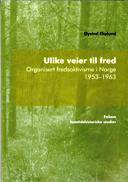A few months after the end of the German occupation in 1945, the Norwegian peace organizations left their wartime hibernation. New organizations were established, and the way forward to secure the new peace was planned. A united peace movement wanted to establish a new public engagement in the campaign for peace. This proved a difficult task. New groups with a security policy agenda were forunded, and these were markedly different from the more established pacifist groups. This exposed the disagreements within the peace movement. Ideological conflict and internal friction made it impossible to build a united Norwegian 'peace front'. The one most unifying struggle, was the fight against nuclear arms. This struggle arrived and then it evaporated.
In a period of cold war with great tension in the international systems, legitimate debate on peace was often very limited, or even politically stigmatizing. Many peace activists endured accusations of crypto-communism, while other were dismissed as naive dreamers.
What - and whom - were the peace movement in the early post-war years? This study investigates the organized popular peace activism in Norway in 1953-63 and examines the activities of the movement, the social foundation and role in Norwegian society.







